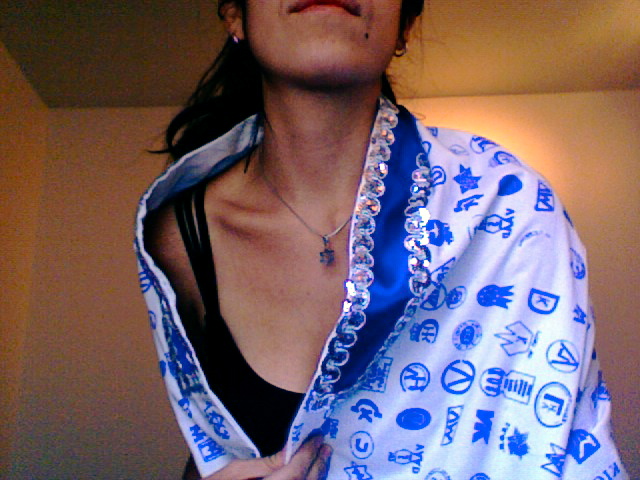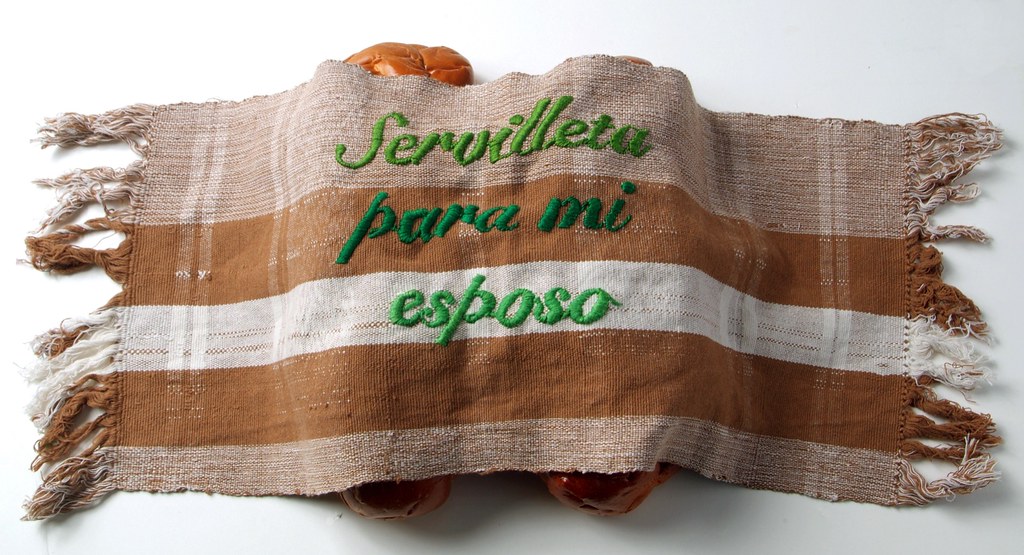Excerpt from the Tzit Tzit: Fiber Art and Jewish Identity Exhibition Catalog, by curator Ben Schacter.
Maya Escobar is a Latina Jew who relishes her ability to blur the boundaries not only between cultures but Jewish denominations. Her Shomer Negiah Panites is an extreme example. The expression shomer negiah refers to the law that limits sexual relations. While a women is menstruating and for several days after, she is not allowed to touch her husband. At the end of this time, she takes a ritual bath called a mikvah. This monthly ritual balances abstinence, cleanliness and intimacy. It is said by those who follow this tradition that time together is made even more precious. Shomer Negiah Panties, 2005Escobar’s work seems to turn this custom on its ear. First, sexuality in the Orthodox community is not publicly displayed. Underwear or anything remotely like it would not be shown in public. Second, part of the function of shomer negiah is one of modesty, not one to tease. But in a twist of modernity, the “tease” can be a way of female control. To exclaim, “Hands Off!” at precisely the moment of greatest vulnerability is exactly what Escobar’s underwear does.Heckshered Tallis presents an air of transgression without doing so. A hecksher is a stamp placed on food to certify that its ingredients and method of processing follows the dietary rules observed by many Jews, called Kashrut. The symbols themselves have nothing to do with prayer and do not belong on a tallis, or prayer shawl, but the obsessive imprimatur suggests an over compensation on the part of the wearer. Women are not required to wear such garments but some congregants of more liberal egalitarian congregations do. Is Escobar suggesting women’s insecurity by obsessively certifying this tallis as “Kosher?”
Shomer Negiah Panties, 2005Escobar’s work seems to turn this custom on its ear. First, sexuality in the Orthodox community is not publicly displayed. Underwear or anything remotely like it would not be shown in public. Second, part of the function of shomer negiah is one of modesty, not one to tease. But in a twist of modernity, the “tease” can be a way of female control. To exclaim, “Hands Off!” at precisely the moment of greatest vulnerability is exactly what Escobar’s underwear does.Heckshered Tallis presents an air of transgression without doing so. A hecksher is a stamp placed on food to certify that its ingredients and method of processing follows the dietary rules observed by many Jews, called Kashrut. The symbols themselves have nothing to do with prayer and do not belong on a tallis, or prayer shawl, but the obsessive imprimatur suggests an over compensation on the part of the wearer. Women are not required to wear such garments but some congregants of more liberal egalitarian congregations do. Is Escobar suggesting women’s insecurity by obsessively certifying this tallis as “Kosher?” Kosher Davening, 2006The pattern of heckshers also creates a fashion akin to a Louis Vuitton print where the fabric is paradigmatic of luxury. Hechshered Tallis brings high fashion and religion together in a satisfyingly truthful and critical way. Even more interesting is the way Escobar’s work comments on different traditions and laws through fashion. Escobar’s oeuvre highlights denominational fragmentation by drawing attention to certain details of Jewish life. The traditional woman who follows shomer negiah would most likely not wear a tallis. Identity is rarely mixed in this way. For an artist to be able to make cross-denominational commentary such as found in Shomer Negiah Panties and Heckshered Tallis takes keen observation. Escobar does not exempt her own experience from such examination.As she shared with me, her family chided her to make napkins for her future, now husband. This traditional role, that is to make the home, chaffed her mildly. She was resistant to such commonplace assumptions about gender so to exaggerate the request, she embroidered “napkin for my husband” across hand woven fabric. Her actions as a wife would thus never be taken for granted.
Kosher Davening, 2006The pattern of heckshers also creates a fashion akin to a Louis Vuitton print where the fabric is paradigmatic of luxury. Hechshered Tallis brings high fashion and religion together in a satisfyingly truthful and critical way. Even more interesting is the way Escobar’s work comments on different traditions and laws through fashion. Escobar’s oeuvre highlights denominational fragmentation by drawing attention to certain details of Jewish life. The traditional woman who follows shomer negiah would most likely not wear a tallis. Identity is rarely mixed in this way. For an artist to be able to make cross-denominational commentary such as found in Shomer Negiah Panties and Heckshered Tallis takes keen observation. Escobar does not exempt her own experience from such examination.As she shared with me, her family chided her to make napkins for her future, now husband. This traditional role, that is to make the home, chaffed her mildly. She was resistant to such commonplace assumptions about gender so to exaggerate the request, she embroidered “napkin for my husband” across hand woven fabric. Her actions as a wife would thus never be taken for granted. Napkin For My Husband, 2007Napkin has been given an additional function, as a challah cover. One covers the challah, or bread made specifically to honor the Sabbath, before the blessing is said and the bread is cut. To embellish a cover heightens the ritual by making the objects beautiful. Napkin tethers together Jewish practice and the work of a relationship. Through her demonstrated knowledge of Jewish custom in her work, one wonders if she also knows Eishet Hayil, a song sung in praise of one’s wife. “A good wife, who can find? She is precious far beyond rubies.” Perhaps Escobar is not so passive aggressively demanding to be serenaded.
Napkin For My Husband, 2007Napkin has been given an additional function, as a challah cover. One covers the challah, or bread made specifically to honor the Sabbath, before the blessing is said and the bread is cut. To embellish a cover heightens the ritual by making the objects beautiful. Napkin tethers together Jewish practice and the work of a relationship. Through her demonstrated knowledge of Jewish custom in her work, one wonders if she also knows Eishet Hayil, a song sung in praise of one’s wife. “A good wife, who can find? She is precious far beyond rubies.” Perhaps Escobar is not so passive aggressively demanding to be serenaded.
